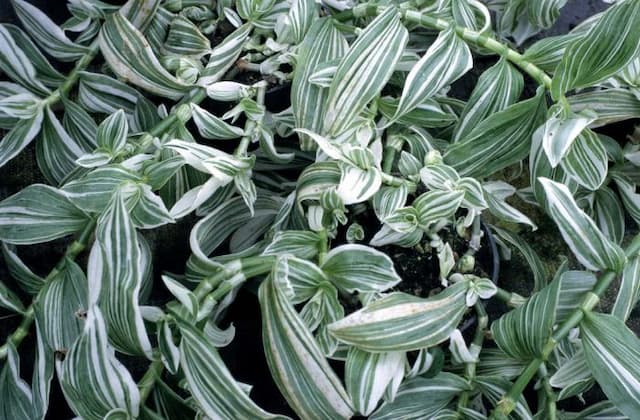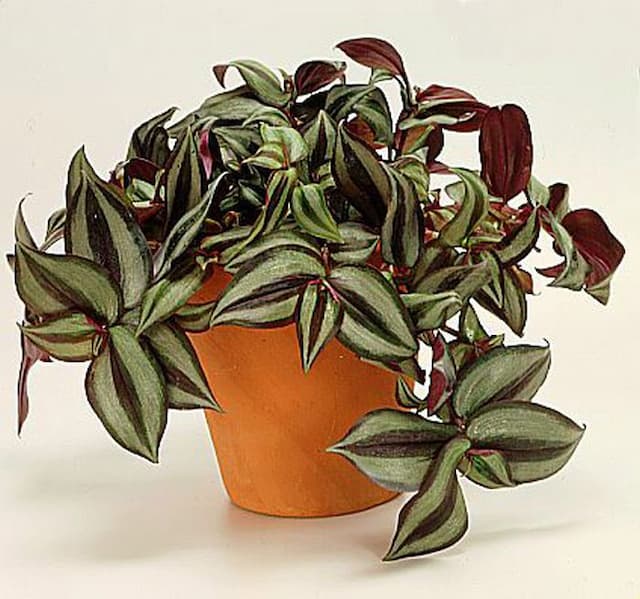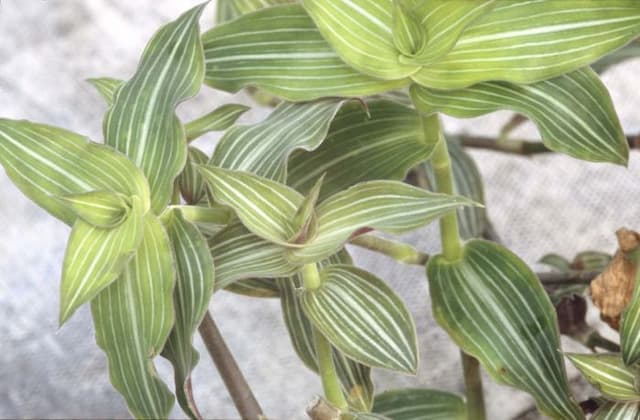Blue Ginger Dichorisandra thyrsiflora

ABOUT
The Blue Ginger is a strikingly beautiful ornamental plant with lush green foliage and unique blossoms. Its leaves, which grow densely along the stems, are glossy, elongated and pointed, resembling those of the ginger plant to which it is not closely related. The vibrant flowers are what really set this plant apart, emerging from upright cone-shaped clusters at the tips of the stems. These blossoms are a deep, iridescent blue to purplish color, with three petals and bright yellow stamens in the center that create a stunning contrast. The flower clusters create a tiered appearance, giving the impression of an elegant floral tower. The attractiveness of the Blue Ginger is further magnified by the way its blooms persist for a long duration, lending a continuous splash of color to its surroundings. Overall, this plant is known for its lush, tropical look and its brilliantly colored flowers that stand out in any garden setting.
About this plant
 Names
NamesFamily
Commelinaceae.
Synonyms
Blue Ginger, Blue-ginger.
Common names
Dichorisandra spectabilis, Tradescantia thyrsiflora, Maranta thyrsiflora, Phaeneilema thyrsiflorum, Uvularia speciosa, Dichorisandra uleana, Thyrsanthema spectabile.
 Toxicity
ToxicityTo humans
Dichorisandra thyrsiflora, commonly known as Blue Ginger, is not listed as a toxic plant to humans. There is no widespread documentation or reports suggesting that Blue Ginger has toxic properties that would cause harm if ingested. However, as with any plant not typically regarded for its edibility, it is generally advisable to avoid consumption due to potential individual allergic reactions or unforeseen consequences. If any part of the plant were ingested and symptoms appeared, it would be best to seek medical advice.
To pets
Blue Ginger is not generally listed as a toxic plant to pets. There is limited information regarding its toxicity to dogs, cats, or other animals. It is not commonly known to cause poisoning in pets. However, since individual animals may react differently to various plants, it is advised to prevent your pets from ingesting it to be cautious. If a pet does ingest Blue Ginger and you notice any signs of distress or unusual behavior, it is prudent to contact your veterinarian.
 Characteristics
CharacteristicsLife cycle
Perennials
Foliage type
Evergreen
Color of leaves
Green
Flower color
Blue
Height
3-4 feet (0.9-1.2 meters)
Spread
2-3 feet (0.6-0.9 meters)
Plant type
Herb
Hardiness zones
10
Native area
Brazil
Benefits
 General Benefits
General Benefits- Aesthetic Appeal: The blue ginger, as it is commonly known, adds vibrant color and exotic beauty to gardens and indoor spaces with its striking blue-violet flowers.
- Attracts Pollinators: It is beneficial for gardens as it attracts bees, butterflies, and other pollinators that are vital for the ecosystem.
- Low Maintenance: Once established in the right conditions, blue ginger requires minimal care, making it a convenient choice for busy gardeners.
- Shade Tolerance: Blue ginger can thrive in partial shade, providing flexibility in garden design and plant pairing options.
- Tropical Foliage: The plant's glossy, dark green leaves add lushness and a tropical feel to landscaping themes.
 Medical Properties
Medical PropertiesThis plant is not used for medical purposes.
 Air-purifying Qualities
Air-purifying QualitiesThis plant is not specifically known for air purifying qualities.
 Other Uses
Other Uses- Dichorisandra thyrsiflora, commonly known as Blue Ginger, can be used in floral arrangements due to its striking blue-violet flowers, adding a tropical touch to bouquets.
- As an ornamental plant, Blue Ginger is sometimes used in garden design to create a lush, tropical feel or as a colorful accent in shaded areas.
- In crafting, Blue Ginger's unique flowers can be used for pressing and can be incorporated into handmade paper or botanical prints.
- This plant's attractive foliage adds a vibrant green backdrop when used in photography or as part of a set decoration in films and theatrical productions.
- During cultural festivals or events, Blue Ginger can be used in decorations and displays due to its visually appealing and durable flowers.
- Blue Ginger can also serve educational purposes, being an example in botany classes to demonstrate plant structure and the diversity of the Commelinaceae family.
- In the culinary arts, while not common, the aesthetic appeal of Blue Ginger flowers can be used as a non-toxic garnish on plates and desserts.
- In personal care, Blue Ginger's essential oil, obtained from its leaves, can be used in the formulation of fragrances or aromatherapy products.
- For dye production, the pigments extracted from the flowers of Blue Ginger can potentially be used to create natural dyes for fabrics or artisan crafts.
- Blue Ginger can be used in the practice of ikebana, the Japanese art of flower arranging, due to its structured form and striking color contrast.
Interesting Facts
 Feng Shui
Feng ShuiThe Blue Ginger is not used in Feng Shui practice.
 Zodiac Sign Compitability
Zodiac Sign CompitabilityThe Blue Ginger is not used in astrology practice.
 Plant Symbolism
Plant Symbolism- Rarity: Dichorisandra thyrsiflora, commonly known as Blue Ginger, is not a true ginger but shares a similar exotic and unique appearance, symbolizing rarity and the value of standing out.
- Tropical Beauty: Originating from tropical rainforests, Blue Ginger represents the lushness and vibrant beauty associated with these ecosystems.
- Uniqueness: With its unique blue-purple flowers, Blue Ginger symbolizes individuality and the appreciation of things that are different from the norm.
- Harmony: The plant's ability to blend with other tropical species in its natural habitat can be seen as a symbol of harmony and cooperation.
 Water
WaterBlue Ginger should be watered regularly to maintain consistent moisture in the soil, especially during the growing season. Aim to water deeply, allowing the water to reach the root zone, about once a week, although frequency may vary depending on climate and indoor conditions. A good rule of thumb is to provide around one-half to one gallon of water every week, adjusting as needed based on the plant's response and the environment. Overwatering can lead to root rot, so ensure proper drainage and let the top inch of soil dry out between waterings.
 Light
LightBlue Ginger thrives in bright, indirect sunlight. The best spot for this plant would be near an east or north-facing window where it can receive plenty of light without the harsh rays of the direct afternoon sun. However, it can adapt to medium light conditions, but growth may be slower.
 Temperature
TemperatureBlue Ginger prefers warm temperatures, ideally between 60 and 80 degrees Fahrenheit. This tropical plant can suffer if exposed to temperatures below 50 degrees Fahrenheit, and it should not be subjected to temperatures below freezing. Keeping the Blue Ginger in a consistently warm environment with little fluctuation in temperature is ideal for its growth and health.
 Pruning
PruningPruning Blue Ginger is mostly done to remove any faded flowers or damaged leaves to encourage healthy growth and maintain an attractive appearance. Light pruning can be done throughout the year as needed, but a heavier prune is best performed in late winter or early spring before new growth begins. Regularly inspecting and removing any unsightly parts of the plant helps to stimulate fresh foliage and flowers.
 Cleaning
CleaningAs needed
 Soil
SoilThe Blue Ginger prefers a rich, well-draining soil mix with a pH of 5.5 to 6.5. Incorporate organic matter such as peat moss or leaf mold and add perlite or river sand to ensure good drainage.
 Repotting
RepottingBlue Ginger should be repotted every 2 to 3 years, or when it has outgrown its current pot, to allow for continued growth and to refresh the soil.
 Humidity & Misting
Humidity & MistingBlue Ginger thrives best in high humidity conditions, ideally above 60%, mimicking its native tropical environment.
 Suitable locations
Suitable locationsIndoor
Place Blue Ginger in bright, indirect light, keep soil moist.
Outdoor
Grow in partial shade, shelter from strong winds, keep soil moist.
Hardiness zone
9b-11 USDA
 Life cycle
Life cycleDichorisandra thyrsiflora, commonly known as Blue Ginger, starts its life cycle as a seed, which upon favorable conditions of warmth and moisture, germinates to produce a small sprout. The sprout develops into a seedling that gradually establishes a root system and sprouts leaves. As the plant matures, it develops a characteristic thick stem and vibrant green, lance-shaped leaves. Blue Ginger reaches its flowering stage, where it bears striking blue to violet flowers arranged in clusters, attracting pollinators for reproduction. Following pollination, the plant forms small capsules containing seeds that, upon maturity, disperse to begin a new cycle. Blue Ginger can also propagate vegetatively through division of rhizomes, thus bypassing seed formation and accelerating the propagation process.
 Propogation
PropogationPropogation time
Spring-summer
The most popular method of propagation for Blue Ginger (Dichorisandra thyrsiflora) is by division. This method is best carried out in the spring or early summer when the plant is emerging from dormancy and is beginning to show new growth. To propagate by division, carefully remove the Blue Ginger plant from its pot and gently separate the rhizomes, ensuring that each division has at least one growth point or shoot. Replant the divisions in fresh potting soil, keeping the soil moist but not waterlogged. Place the pots in indirect light and maintain a temperature around 70 degrees Fahrenheit (about 21 degrees Celsius). Roots and new shoots should appear within a few weeks, indicating successful propagation.



